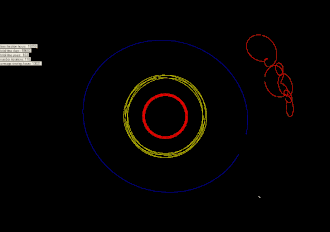Troià de Neptú

Un troià de Neptú (anomenat així per analogia amb els asteroides troians de Júpiter) és un cos similar als objectes del cinturó de Kuiper en òrbita solar que té el mateix període orbital que Neptú i segueix aproximadament el mateix camí orbital.[1] Sis dels set trobats fins al moment es troben en la regió elongada i corba al voltant del punt de Lagrange Sol-Neptú L₄ 60° al davant de Neptú.

El descobriment de 2005 TN53 en una òrbita altament inclinada (>25°) fou interessant, ja que suggerí un núvol de troians 'espès'[2] (Els troians de Júpiter tenen inclinacions de fins a 40°[3]). Es pensa que el nombre de troians de Neptú amb radis grans (radi ≈ 100 km) podria superar el de troians de Júpiter en ordre de magnitud.[4][5]
Tant 2005 TN74[Nota 1] com 2007 RW10, en el moment del seu descobriment es pensà que eren troians de Neptú, però posteriorment es reclassificaren.
El 12 d'agost, s'anuncià el descobriment del primer troià de Neptú L₅, 2008 LC18.[6] La regió L₅ fou molt difícil d'observar, ja que es troba al llarg de la línia de visió al centre de la galàxia, una àrea del cel amb moltes estrelles.
Objectes troians de Neptú
[modifica]Fins al moment s'hi han descobert set troians de Neptú.
| Designació provisional |
Punt de Lagrange |
Periheli (AU) |
Afeli (ua) |
Inclinació (°) |
Magnitud absoluta |
Diàmetre (km) |
Any de Descobriment |
Referències |
|---|---|---|---|---|---|---|---|---|
| 2001 QR322 | L4 | 29.428 | 31.349 | 1.3 | 8.2 | ~140 | 2001 | |
| 2004 UP10 | L4 | 29.351 | 31.259 | 1.4 | 8.8 | ~100 | 2004 | |
| 2005 TN53 | L4 | 28.253 | 32.284 | 25.0 | 9.1 | ~80 | 2005 | [2] |
| 2005 TO74 | L4 | 28.733 | 31.824 | 5.2 | 8.5 | ~100 | 2005 | |
| 2006 RJ103 | L4 | 29.345 | 31.005 | 8.2 | 7.5 | ~180 | 2006 | |
| 2007 VL305 | L4 | 28.131 | 32.171 | 28.1 | 8.0 | ~160 | 2007 | |
| 2008 LC18 | L5 | 27.547 | 32.468 | 27.5 | 8.4 | ~100 | 2008 | [7] |
Notes
[modifica]- ↑ 2005 TN74, identificat primerament com a troià de Neptú, és probable que sigui un objecte trans-neptunià en ressonància 3:5 amb Neptú.
Referències
[modifica]- ↑ Minor Planet Center. «List Of Neptune Trojans» (en anglès), 13-08-2010.
- ↑ 2,0 2,1 Sheppard, Scott S.; Trujillo, Chadwick A. «A Thick Cloud of Neptune Trojans and Their Colors» (
PDF) (en anglès). Science, 313, 5786, 26-02-2008, pàg. 511–514. DOI: 10.1126/science.1127173. PMID: 16778021.
- ↑ Jewitt, David C.; Chadwick A.; Luu, Jane X. «Population and size distribution of small Jovian Trojan asteroids» (en anglès). The Astronomical journal, 120, pàg. 1140–7. DOI: 10.1086/301453.
- ↑ E. I. Chiang and Y. Lithwick Neptune Trojans as a Testbed for Planet Formation, The Astrophysical Journal, 628, pp. 520–532 Preprint
- ↑ Powell. «Neptune May Have Thousands of Escorts» (en anglès). Space.com, 08-03-2007.
- ↑ Scott S. Sheppard. «Trojan Asteroid Found in Neptune's Trailing Gravitational Stability Zone» (en anglès), 28-12-2007.
- ↑ Sheppard, Scott S.; Trujillo, Chadwick A. «Detection of a Trailing (L5) Neptune Trojan» (en anglès). Science. AAAS, 329, 12-08-2010, pàg. 1304. DOI: 10.1126/science.1189666.
Enllaços externs
[modifica]- Planetary Trojans - the main source of short period comets? (arXiv:1007.2541 : 15 Jul 2010)
